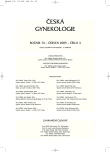New diagnostic approach to different hydatidiform mole types, hydropic abortions and relevant clinical management
Authors:
M. Zavadil; J. Feyereisl; L. Krofta; P. Šafář; I. Kučerová
Authors‘ workplace:
Ústav pro péči o matku a dítě, Praha, ředitel doc. MUDr. J. Feyereisl, CSc.
; 3. lékařská fakulta Univerzity Karlovy, Praha
; Centrum pro trofoblastickou nemoc v ČR, vedoucí doc. MUDr. M. Zavadil, DrSc.
Published in:
Ceska Gynekol 2009; 74(3): 177-182
Overview
Objective:
To describe new diagnostic approach to complete hydatidiform mole, immature complete hydatidiform mole, partial hydatidiform mole, proliferative mole and hydropic abortion.
Type of study:
Original research.
Setting:
Trophoblastic Disease Center in the Czech Republic (TDC-CZ), Institute for the Care of Mother and Child, Prague.
Methods:
Our study consists of 1321 partial hydatidiform moles, 805 complete hydatidiform moles, 524 proliferative moles, and over 2500 hydropic abortuses diagnosed and treated at theTDC-CZ, besides which 2896 of these lesions were examined at theTDC-CZ by referral. The material was examined by routine histopathological methods, which in selected cases was supplemented by immunohistological examination and correlated with cytogenetic and molecular genetic results and clinical features.
Results:
The study describes the diagnostic procedures enabling the differential diagnosis between mature complete hydatidiform mole, immature complete hydatidiform mole, partial hydatidiform mole, proliferative mole and hydropic abortion. Fourteen histological parameters have been defined which are most common, individually or in combination, in various types of hydatidiform moles and hydropic abortions. Warning is given to errors in histological diagnosis correlated with cytogenetic and molecular genetic results. Proposed reliable method of eliminating the influence of these errors on the possible development of trophoblastic disease.
Conclusion:
The study describes differential diagnosis of complete hydatidiform mole, immature complete hydatidiform mole, partial hydatidiform mole, proliferative mole, hydropic abortion and relevant clinical management.
Key words:
complete hydatidiform mole, immature complete hydatidiform mole, partial hydatidiform mole, proliferative-invasive mole, hydropic abortion – differential diagnosis, clinical management.
Sources
1. Kajii, T., Kurashige, H., Ohama, K., Uchino, F. XY and XX complete mole: clinical and morphological correlations. Am J Obst Gyn,1984, 150, p. 57-64.
2. Maggiori, MS., Peres, LC. Morphologic, immunohistological and chromosome in situ hybridization in the diferencial diagnosis of hydatiform mole and hydropic abortion. Eur J Obst Gyn, 2007, 135, p. 170-176.
3. Miller, RT. Evalution of hydropic placentas (Hydropic degeneracion vs. parcial mole vs. comlete mole). March 2003 www.propathlab.com.
4. Ober, WB., Fass, RO. The early history of choriokarcinoma. J Med Allied Scie, 1951, 16, p. 49-73.
5. Szulman, AE., Surti, U. The syndromes of hydatiform mole. I. Cytogenetic and morfological correlations, Am J Obst Gynec, 1978, 131, p. 665-671.
6. Szulman, AE., Surti, U. The syndromes of hydatiform mole. II. Morfologic evolution of the complete and partial mole. Am J Obst Gyn, 1978,132, p. 20-27.
7. World Health Organisation Scientific Group. Gestational trophoblastic diseases. Technical Report . 1983, Serie 692.
8. Zavadil, M. Trophoblastic Disease l-lll.Acta Univ Carol. Med, 1973, p. 1-107.
9. Zavadil, M., Feyereisl, J., Hejda, V., et al. Histopatologická diferenciální diagnostika hydatidózních mol a hydropických abortů. Čes-slov Patol, 2009, 45, 1, s. 3-8.
10. Zavadil, M., Feyereisl, J., Krofta, L., et al. Perzistující trofoblastická nemoc v Centru pro trofoblastickou nemoc v ČR v letech 1955-2007. Čes Gynek, 2008, 73, 2, s. 73-79.
11. Zavadil, M. Trofoblastická nemoc. Kapitola 24. In Roztočil, A. Moderní gynekologie. Grada Publishing, Praha, 2009, v tisku.
Labels
Paediatric gynaecology Gynaecology and obstetrics Reproduction medicineArticle was published in
Czech Gynaecology

2009 Issue 3
Most read in this issue
- Unwanted children
- Uterine torsion – the rare compliation of pregnancy
- Common variable immunodeficiency (Set of case reports)
- New diagnostic approach to different hydatidiform mole types, hydropic abortions and relevant clinical management
